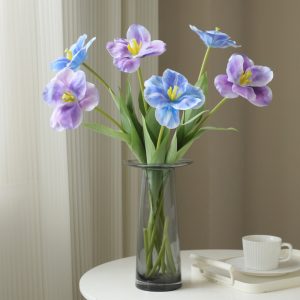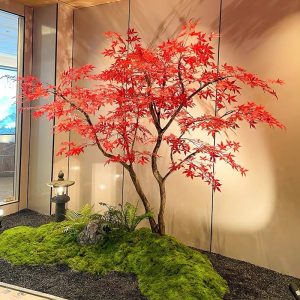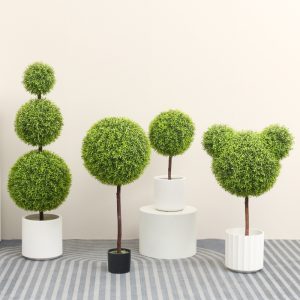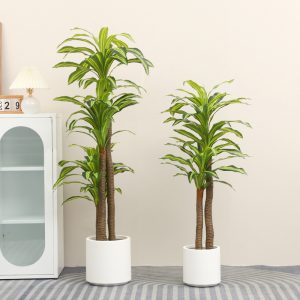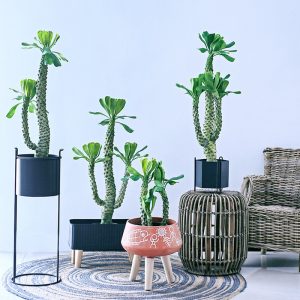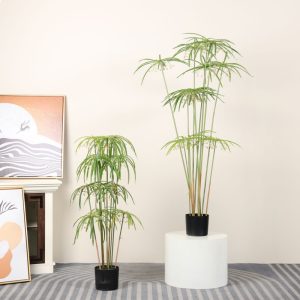7 a.m. in Paris, the autumn sun filters through the stained-glass windows of a boutique hotel on Avenue George V, casting dappled shadows on the parquet marble floor. Standing in the center of the lobby with the hotel designer, Claire, we watch as the cleaner gently brushes the leaves of the plant beside the spiral staircase. The crimson tips glisten with a velvet-like sheen in the light.
“The texture is incredible,” Claire can’t resist running her fingers over the leaves, the delicate fuzz making her exhale softly. “When the board visited last week, three directors thought it was an imported rare red velvet potted plant—no one believed it was artificial plant red velvet.”
A faint fig aroma lingers in the air of the lobby. Beneath the six-meter-high dome, several clusters of artificial plant red velvet are arranged along the cascading path of the crystal chandelier—nearly two-meter-high main stalks lean against a gilt-framed mirror, leaves spreading like butterfly wings, with pale-red centers fading into deep-crimson edges. The most ingenious piece is the greenery composition on the backdrop behind reception, where artificial red velvet intertwines with silver-gray ferns in brass planters, reflecting the soft sheen of the velvet leaves. This kind of hotel-grade artificial plant red velvet blends into the space with quiet elegance.
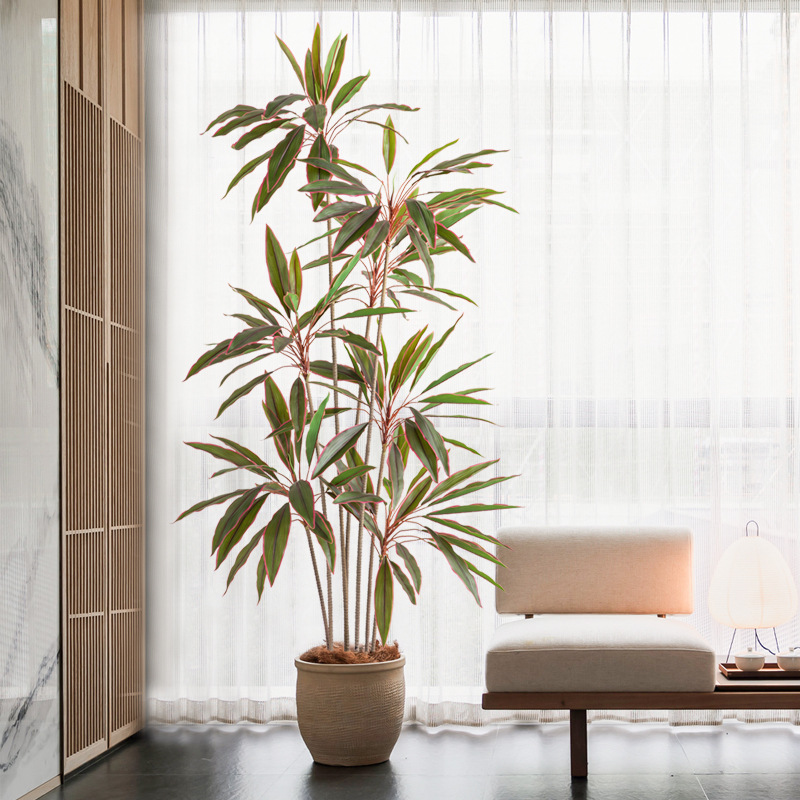
Touch & Light: The Spatial Magic of Artificial Plant Red Velvet
On our way to the terrace, Claire stops suddenly by a flower stand at the hallway corner: “Look at this new ‘tender leaf’—even the density of the fuzz is exactly the same as a real red velvet plant.”
Up close, the leaf surface is covered with a layer of ultra-fine artificial velvet fibers, with a slight resistance to the fingertip. The edges are intentionally curled for a natural look, and in the slanted sunlight, the interplay of light between the fibers shimmers like flowing gold dust.
The restaurant’s décor is even more thoughtful. In a retro setting of walnut tables and cream velvet chairs, every table features a small artificial plant red velvet potted plant in the center. Under the warm lighting, the crimson leaves give off a soft glow. The restaurant manager, Marie, walks by with a tray and laughs: “Since switching to these artificial plants, we no longer have to worry about leaves wilting or yellowing every day.” Rotating the pot, she adds: “The most surprising thing is guest feedback—many say this splash of red makes their breakfast feel warmer, and table requests for ‘near the greenery’ have gone up 30%.”
In the afternoon executive lounge, sunlight streams through blinds, casting striped shadows on the carpet. Beside the window booths, two medium-sized artificial plant red velvets stretch their leaves. The leaf veins are clearly visible on the underside, with slightly lighter fuzz than the front—perfectly mimicking real growth patterns. “When we had real red velvet plants, we replaced them twice a week,” says Pierre, the lounge supervisor, bringing coffee. “They were too delicate—three days of air conditioning wind and the leaves would drop. Now, with these artificial plants, not only have we cut maintenance costs, but the leaf sheen stays more consistent.”
The Rational Choice: Why High-End Hotels Favor Artificial Plant Red Velvet
“When I first suggested artificial plants, the owner nearly vetoed it,” Claire recalls, stroking the artificial red velvet leaves in the elevator lobby. “They thought ‘fake plants’ didn’t match the hotel’s light-luxury positioning—until we ran a two-week comparison.” She points to a display: real red velvet plants curled and yellowed in the air conditioning, with roots rotting from overwatering; ordinary artificial red velvet looked stiff, with plastic-like gloss; but this high-polymer velvet artificial plant stayed perfectly open, with color shifts in varying light more stable than the real thing.
In the back-of-house corridor leading to the banquet hall dressing room, engineering manager Lucas reveals a deeper advantage. Even in the dim, humid passage, several artificial plant red velvets maintain their vibrant color, their fuzz unmarred by clumping. “Here, humidity stays over 60% year-round—real red velvet molds in three days,” Lucas says, shining a flashlight at the base. “These artificial plants have water-repellent fibers—just wipe with a damp cloth, and it’s clean. That’s huge for hotel hygiene standards.” Since switching to hotel artificial plant red velvet, maintenance labor costs have dropped 70%, saving nearly €12,000 annually.
Sophie, the purchasing director, highlights compliance: “Hotels in Europe and America choose plants not just for looks but also regulations.” She points to the test report—this batch of artificial red velvet meets EU REACH certification, with allergen-free fibers safe even for children. “Last week, a guest with allergies left a note saying it was the first time they could get close to a ‘red velvet plant’ without worry.”
From Dawn to Dusk: The All-Day Aesthetic of Hotel Artificial Plant Red Velvet
At night, the lobby transforms. Warm wall sconces cast golden trims on the artificial plant red velvet leaves. By the concierge desk, the main plant’s edges glow amber under the spotlight. “Evening guests love taking photos here—especially couples,” says Antoine, the night manager, showing social media photos where the plants retain their fine velvet texture in low light, free from the telltale plastic shine of cheap artificial plants.
In the 24-hour gym, small artificial plant red velvets stand fresh in the corner. “Real plants here used to curl from the AC wind, and watering risked the circuits,” says trainer Emma. “Now, members glance at that splash of red and say it wakes them up more than a white wall.”
After a morning rain, water beads along the velvet fuzz of the artificial red velvet, gathered delicately at the leaf edges. Garden consultant Jean sweeps them with a soft brush: “Real red velvet fibers mat after rain—this artificial material stays fluffy.”
More Than Decoration: The Emotional Value of Artificial Plant Red Velvet
Business traveler Mr. Brown asks at checkout about the lobby plant: “My wife loves red velvet plants, but they never survive at home.” Learning it’s artificial, he requests the supplier’s info: “Seeing that red every day here felt warm.”
Wedding planner Amelie strokes the artificial red velvet in the banquet hall: “The bride wants a ‘red velvet forest’ theme, but real plants shed and trigger allergies.” The artificial vines don’t shed fibers, colors stay even, and every leaf photographs perfectly. More and more event planners now put artificial plant red velvet at the top of their lists.
On my last morning, I pass through the lobby again, seeing an elderly couple posing beside the artificial red velvet. The husband gently steadies his wife, her hand touching the leaf: “This plant looks exactly like the red velvet potted plant we saw on our honeymoon in Brazil.” Sunlight streams through the velvet fuzz, falling softly on their silver hair.
From Paris morning mist to New York nightscapes, artificial plant red velvet is quietly redefining hotel aesthetics—not imitating nature, but keeping the warmth of tropical velvet leaves alive in temperate city spaces.







